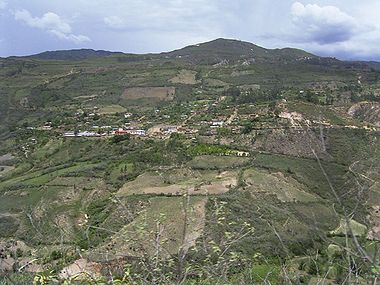Magdalena (Chachapoyas)
| Magdalena | |
|---|---|
| District: | Magdalena |
| Province: | Chachapoyas |
| Region: | Amazon |
| Height (capital): | 1980 m. ü. d. M. |
| Surface: | 135.47 km² |
| Population: | 880 (as of 2005) |
| POLITICS | |
| Mayor: | Prof. Diógenes H. Zavaleta Tenorio |

Magdalena is the capital of the Magdalena district of Peru in the Chachapoyas province in the Amazonas region . Magdalena is located where the mountains flatten towards the Utcubamba River . From Magdalena you have a wonderful view of Kuelap . You can get to Magdalena by car from Chachapoyas (Peru) .
Attractions
The festival of the village saints
The village festival in the district capital Magdalena is celebrated on the day of Maria Magdalena, on July 20th. There is a parade with groups in traditional clothing. In addition, various communities in the village present their handicrafts (e.g. making sugar cane schnapps or traditional handicrafts).
The feast of the Colegio
The founding anniversary of the Magdalena secondary school, the Colegio Cesar Vallejo (named after a Peruvian writer) on October 18th is also worth a visit, on this day there are mostly performances of folk dances and traditional food.
The ruins of Makro
To this day it is unclear what purpose the diverse house constructions once served. They are definitely worth a visit. To do this, walk from the village of Magdalena towards Utcubamba , the path is signposted. If you want to save time, Don Felix can take the cable car (Oroya) over the Utcubamba and then only have to walk the last 100 meters.
Shihual's cave
If you follow the path that leads through the ruins of Makro, you come to Shivual's cave. It is advisable to visit this place in the company of a competent guide and with the appropriate equipment, as the cave is not adequately secured and explored. The German anthropologist Peter Lerche , who does research in the area, suggested that the cave above the ruins of Makro has a second entrance. Due to a lack of funds, the cave has not yet been fully explored. Inside the cave you can find a cemetery, paintings and wall constructions of the Chachapoya culture .
Magdalena's village square
A small replica of the Macro ruins can be found in the village square. You can also see the Church of Magdalena and the local women's cooperative that produces and sells handicrafts.
The Church of Magdalena
In addition to the figures of Saint Francis and Maria Magdalena, you can see a historical cross from the mid-19th century in the church. The high altar of the church collapsed in the mid-1980s. The church is mainly made of wood and adobes (adobe).
The legend of Magdalena
Magdalena's grandparents still tell their grandchildren the legend that tells why the village of Magdalena is halfway up the slope and not on top of the mountain.
Once upon a time, the village of Magdalena was on top of the mountain. In addition to many children and adults, the houses and the cattle, there was a priest in Magdalena at that time who was in possession of magical powers, he could see the future. So one day, while he was praying in front of Maria Magdalena in his little church, he saw that a catastrophe would strike the village at midnight. Excited, he left his little church to warn the people in the village. It wasn't just any day, it was July 20th, the feast of Mary Magdalene and the people celebrated a big feast in the center of the village. They didn't want to listen to the priest and kept partying until late at night. But the priest went into the little church, took the Holy of Holies and the statue of Mary Magdalene and went down on the mountain. Halfway up the mountain he came across a little hut. He put the statue in there and that wasn't too early. At that moment, a severe earthquake shook the whole mountain. The entire village high up on the mountain was destroyed. But a small hut on the edge of the mountain had survived the earthquake undamaged. It was the hut in which the statue of Maria Magdalena now stood. The people from the village saw that the little hut had survived the earthquake unharmed. The next day they began to build a church on the spot where the hut stood. When the church was finished, people began to rebuild the village around the church.
And where the hut once stood, the church still stands today.
And whoever climbs the mountain will encounter the ruins of the houses that were destroyed in that earthquake.
typical dishes
In Magdalena you can eat the sancochado, the mote, the chocho, the locro de mote pelado, dishes that are mainly made from corn, wheat, rice and potatoes and of course the roasted guinea pig.
See also
Web links
Coordinates: 6 ° 28 ′ S , 77 ° 29 ′ W


